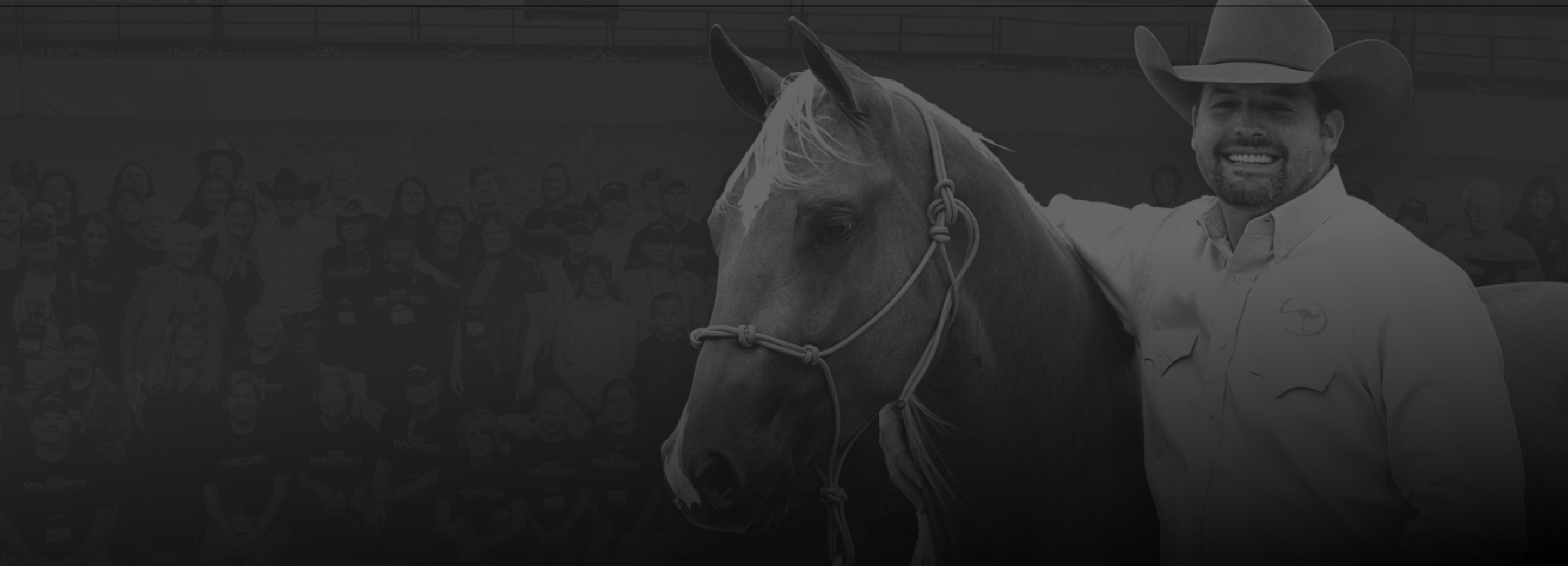Clinton Anderson from Downunder Horsemanship has developed an effective method to train horses, regardless of their age, history, or any behavioral issues and past traumas. Join him on his weekly endeavors of tackling some of the most challenging situations with problem horses, and with problem owners. This week, we’ll watch Clinton as he continues his training with his 6-year-old Quarter Horse mare, Cider.
Cider has been in many of Clinton’s past episodes. She’s was an abused mare that came from Habitat for Horses and had a number of behavioral problems. Mainly, she was afraid of humans, which made training difficult. Clinton has been continually working with Cider to help correct her behaviors so that eventually, she’ll be ready to be given to a new owner.
Today, Clinton helps us understand how to have a secure seat in the saddle and shows some training exercises you can do to develop one. Inexperienced riders tend to grab at their horses with their hands and legs when they feel scared, but this only causes more problems. The key is being confident and creating a secure seat so that even if you don’t have the reins, you still have balance and control.
Clinton starts the show by doing some groundwork with the bridle or mecate rein set. Remember, moving your horse’s feet and getting them ready to ride is important for any safe and successful ride. This starts with putting on the bridle correctly. Clinton takes some time to show us good and bad bridling habits so you can start off on the right foot with your horse. He then moves on to groundwork. He does the Sending Exercise and Lunging for Respect to warm Cider up and get her light on the ground so she’s ready to ride. He then goes to tighten the cinch with his uniquely designed girth before getting on her so that he can share how to work towards developing a secure seat. By using Clinton’s specially designed girth, your horse will experience a lot less friction making the ride much more comfortable. The more comfortable your horse is, the more receptive they are to their riders. It’s a win-win situation.
Once you put the girth on, you want to move the horse’s feet a tad more to help get them comfortable with how the girth feels. Don’t try to mount them right away. Warm them up to the feeling of the equipment so they don’t get spooked when it’s time to carry a rider. When Clinton does get on Cider, the first thing he does is to reinforce lateral flection—flexing her head left and right to ensure that she’s soft and light in his hands. Lateral flection is the key to vertical flection, which is essential in teaching a horse how to collect and properly carry themselves. He continues to work Cider by yielding the hindquarters while he’s in the saddle to get her to use the thinking side of her brain. The goal is to teach Cider to be responsive to leg cues. Where Clinton puts his leg determines what part of Cider’s body he wants her to move.
You need to gain control of the five body parts on your horse: head and neck, poll, shoulders, ribs, and hips. Having control of your horse will give you confidence to develop a secure seat. After flexing Cider and asking her to yield her hindquarters, Clinton moves on to an exercise called Yield to a Stop which is a great transition exercise to practice for horse and rider. He reminds us that it’s very important to wait until the horse stops and softens before you let the rein go, because otherwise you’re rewarding bad behavior.
As Clinton continues to move through his exercises, explaining how they help create a secure seat, he reminds us that you need to make sure that you’re consistent, patient, and continually repeat the same exercises throughout your training. It takes some time for these habits to become engrained in your horse’s memory, so just stick with it and eventually you’ll see a transformation in your horse. He recommends pairing your training with the Aussie Saddle to allow for more security and feel when you’re on your horse. The Legacy boots for both the front and hind legs will help keep your horse comfortable during training and will protect them from tendon or ligament damage.
Clinton Anderson has developed a method to help train any horses, regardless of their problem. Unfortunately, up until now it was nearly impossible to access the Method when you’re on the go or at the barn. That’s why we’ve created three new ways to get the content you need at the price you want. Our Downunder Horsemanship app gives you access to your digital training kits and allows you to download videos and training content directly to your mobile device or view them on your computer. The Downunder Horsemanship app also offers over 100 hours of free, in-depth training content. You can also access all of the training material through three different levels by joining our No Worries Club.
To learn more about the Clinton Anderson training method, become a member of the No Worries Club, or to get information on any of the products seen on our show, head over to our homepage and download the Downunder Horsemanship app today! If you’re interested in getting accelerated results, let a Clinton Anderson Certified Clinician bring the method to you!

Master Your horsemanship Skills
Like these tips? Join the No Worries Club and hone your skills with thousands of hours of Clinton’s easy, step-by-step method horse training videos.



